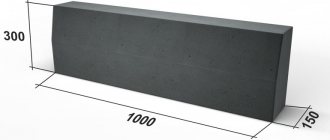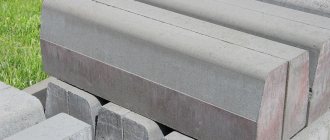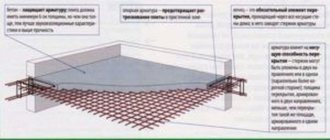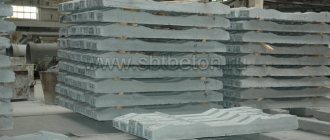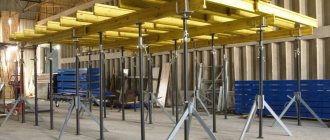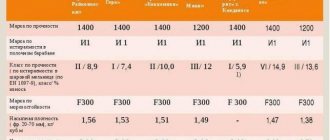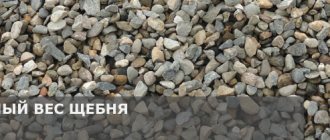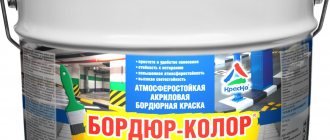Road curbs are factory-made products that have certain technical characteristics in accordance with current regulations and standards.
In order to correctly calculate the load, as well as the load-carrying capacity of equipment for unloading and installing products, you need to know all the physical and mechanical parameters of the side stone.
The weight of the road curb depends on a number of criteria and is indicated in the quality certificate attached to each batch of products sold.
SNiP 35-01-2001 and GOST 6665-91
Interestingly, the document (building codes and regulations), which should help cyclists overcome curbs and easily enter sidewalks, is intended for the design, construction and reconstruction of buildings and structures that are accessible to all groups of people with limited mobility. Here the interests of cyclists coincide with the interests of wheelchair users. And since Russia signed the Declaration of the Rights of Persons with Disabilities, adopted by the General Assembly in 1975, there are articles in the legislation that are useful to us, cyclists.
Quote from the current SNiP 01/35/2001:
3.4 The height of curbs along the edges of pedestrian paths on the site is recommended to be at least 0.05 m. The height of the side stones at the intersection of sidewalks with the roadway, as well as the difference in heights of curbs, side stones along maintained lawns and green areas adjacent to pedestrian traffic routes, should not exceed 0.04 m.
This “SNIP” (building codes and regulations) is included in the international Classification ISO 91.040.01, which provides people with disabilities the opportunity to lead an active lifestyle.
The difference between a curb and a curb
As you understand, curbs and curbs are elements that separate the sidewalk from the roadway or delimit different zones of pedestrian paths (for pedestrians and bicycles, for example). So what is the difference between a curb and a curb?
What is the difference between a curb and a curb - the installation method. Namely, at what height its top is located
If you thought it was size or shape, then you were wrong. They are made from identical elements, which manufacturers call side or curb stones. The only difference is how they are installed. If the surface of the side stone is flush with the covering, then it is a curb. If part of the height protrudes above the covering level and forms some kind of obstacle, this is a curb. That is, it depends on how deep you bury the curb block.
Why do you need to know the mass of the curb?
The weight of road curbs is the most important indicator that allows you to achieve the following results :
Calculation of the strength of the soil foundation to make a decision on organizing its strengthening.- Determining the total weight of the pallet for the possibility of unloading transport upon arrival of the product at the site.
- Choosing a method for installing curbs in the design position.
- Selecting the right truck for moving products in case of self-pickup.
One of the main reasons why you need to control the weight of a concrete or granite curb is to check the quality of the product. If, during control weighing, the weight of the product turns out to be less than stated in the passport, this means a violation of the recipe when mixing concrete, or the use of a less durable and dense stone instead of granite.
What dictionaries say
Great Dictionary of Russian language. edited by S.A. Kuznetsova states that:
«CURBRICK
:
1.
Bordering the edge of the sidewalk, separating the roadway from the pedestrian path;
curb
(2 digits).
2.
Ornamental brickwork, in which one row of bricks is laid at an angle to the outer surface of the wall.”
A " BORDURE"
:
1.
A colored stripe that frames the edges of something.
2.
Bordering the edge of a sidewalk, road, etc.;
curb
(1 digit)".
T.F.’s explanatory dictionary also agrees with the above. Efremova. This means that the use of both words is normative, neither of them is marked “dialectal”!
What will GOSTs say about their meaning?
Photo taken in May 2013.
Types of borders according to standard
In general, it is correct to talk about the types of side stones. Side stone is a dividing element in the construction of roads, sidewalks, and pedestrian areas. Prevents soil from washing onto the paved part. It is a product made of concrete or reinforced concrete (reinforced concrete), which has a large length and a small cross-sectional area. It is highly resistant to loads, static and shock loads. All its characteristics and properties are described in GOST 6665-91.
For road construction, only side stones are used in accordance with GOST
According to the standard, curbs are made of sand concrete or heavy concrete (with gravel filler). Brand - not lower than M300, but is selected depending on weather and climatic conditions. Oddly enough, but for the central southern regions a higher grade is required than for the northern ones. The fact is that higher grades have a higher level of frost resistance. In such a climate, there can be up to 20 freeze/thaw cycles in one winter. So the minimum acceptable frost resistance is 400 cycles (F400) and above.
Standard types of curb stones
Borders are used to separate roads, sidewalks and green areas, design flower beds and separate trees. In general, the scope of application is wide. To create the required relief, not only straight, but also curved elements are needed. Here are the types defined in GOST:
- Direct: BR - ordinary;
- BU - with widening;
- BUP - with intermittent broadening;
- BL - with tray;
Types of side stones according to the standard and their drawings (profiles)
According to the standard, curbs that separate the sidewalk from the roadway must be made of concrete with a strength class of at least B30. If it is necessary to separate pedestrian paths from lawns, the strength can be B22.5.
Legend
The markings include the name of the stone in the form of letters, and then indicate the length, height and width. In this order, separated by dots. Dimensions are indicated in centimeters. Then the class of reinforcement, if any, is indicated.
Dimensions and requirements for curbs and curbs are described in GOST 6665-91
An example of marking and its explanation:
- BR 100.30.18. This reads as an ordinary border (straight) without reinforcement, 100 cm long, 30 cm high and 18 wide.
- BK 80.30.15 - AV. The meaning of this marking is a curved border (actually a side stone) 80 cm long, 30 cm high, 15 cm wide. The reinforcement class is AV (A5).
Dimensions of borders according to GOST
The standard length of the side stone is available in three versions: 100 cm, 300 cm and 600 cm. The height of the ordinary ones is 15 cm and 18 cm, 1 meter and 3 meters long, six-meter ones can have another 20 cm.
Standard border sizes are not small
Please note that the bevels, their shape and size are also specified. Possible options are also described. So, the marking indicates the width along the widest part. This is usually the sole.
| Marking | Length, mm | Width, mm | Height, mm | |
| BR 100 | 1000 | 300 | 150 and 180 | There is also BR 100.20.80 - with a width of 20 cm and a height of 80 cm, it is usually called garden |
| BR 300 | 3000 | 300 and 450 and 600 | 150 and 180 and 200 | |
| BR 600 | 6000 | 300 and 450 and 600 | 150 and 180 and 200 | |
| BU 300 | 3000 | 290 and 320 | 300 | The width in the marking is indicated according to the “sole” |
| BUP 300 | 3000 | 290 and 320 | 300 | Width is measured at the widest part |
| BUP 600.30.32 | 6000 | 320 | 300 | |
| BL 300 | 3000 | 680 and 930 and 1180 | 320 | Width is measured at the widest |
| BV 100 | 1000 | 150 and 180 | 300 | |
| BC 100 | 1000 | 180 and 200 | 300 | Rounding radius for BC 5 – 5000mm for BC 8 – 8000mm for BC 12 – 12000mm for BC 15 – 15000 mm |
There may also be questions about curved curb blocks. GOST allows the production of curves with a radius of 5, 8, 12 and 15 meters. The standard contains a note that it is allowed to produce copies of other sizes by agreement with customers. Since almost all of the listed options are too massive for a private courtyard, factories often produce smaller borders. For example, BR 50.20.80. Its weight is about 18-20 kg, so it is quite possible to install it yourself.
Curb weight
Since curbs and curbs can be made from concrete with different aggregates, its weight may vary. The standard specifies a reference weight, but the exact weight must be obtained from the manufacturer.
The weight of the curb depends on its size
Curbs one meter long can be made of sand concrete or heavy concrete, longer ones - 3 and 6 meters - only made of heavy concrete. Sand concrete must be vibrated in order for it to be strong enough. It is allowed to use additives that increase strength and frost resistance.
| Curb brand | Weight, kg | Curb brand | Weight, kg | Curb brand | Weight, kg |
| BR 100.30.15 | 100 | BR 600.20.-A-IV (AV) | 760 | BL300.32.118 | 1690 |
| BR 300.30.15 | 320 | BR 100.20.8 | 40 | BV 100.30.15 | 100 |
| BR 600.30.15-A-IV | 640 | BU 300.30.29 | 400 | BV 100.30.18 | 120 |
| BR 100.30.18 | 120 | BUP 300.30.29 | 340 | BC 100.30.18.5 BC 100.30.18.8 BC 100.30.18.12 BC 100.30.18.15 | 120 |
| BR 300.30.18 | 380 | BU300.30.32 | 470 | BK 100.30.21.5 BK 100.30.21.8 BK 100.321.12 | 140 |
| BR 600.30.18-A-IV | 770 | BUP300.30.32 | 410 | Ramp stone | according to the project |
| BR 300.45.18 | 580 | BUP300.30.32-A-IV | 790 | ||
| BR 600 45.18-A-IV (AV) | 1170 | BL300.32.68 | 1050 | ||
| BR 300.60.20 | 880 | BL300.32.93 | 1370 |
Vertical and horizontal edges must be perpendicular. Maximum permissible deviations have been established - they do not exceed 3-4 mm.
Calculation principle
A simple formula is used to calculate the weight of a granite curb. You will need several data :
length of the product;- width;
- height (thickness);
- specific gravity of the stone.
The specific gravity of granite is from 2700 to 3000 kg/m3. The exact data depends on the type of stone (deposit).
For calculation, you can take the average value - 2900 kg/m3. All that remains is to multiply all four values and get the desired result.
For example, curb length 1000 mm, width 300 mm, height 150 mm, specific gravity 2900 kg/m3. Estimated product weight = 130.5 kg. This is an approximate value, because the average specific gravity is taken into account. For example, the stone from the Kurtinskoe deposit has a specific gravity of 2640 kg/m3. As a result of multiplication we get 118.8 kg.
In the case of calculating a concrete curb, instead of the specific gravity, you need to know the density of the concrete. If you need data on a reinforced concrete curb, you will additionally need to know the weight of the reinforcement.
The formula contains 3 parameters:
- type of fittings used;
- concrete density;
- form.
The consumption of reinforcement for a product is a reference value and is indicated in regulatory documents.
For a typical rectangular shape:
m=l x b x c x p+ma
Where:
- l—length;
- b—width;
- h—height;
- p is the density of concrete and ma is the weight of the reinforcement.
Example : Curb dimensions 1000x300x180, density 2400 (kg/m3). As a result, we get weight = 129.6 kg. If there is reinforcement, then the reference mass value should be added.
sidewalk curb
When choosing a sidewalk curb, you need to pay attention to technical indicators.
physical characteristics
These include:
- Durability brand. Concrete must have a grade strength of M400 and higher.
- Concrete class. Concrete class B30 is recommended (concrete strength 39.29 MPa).
- Frost resistance. The curb stone should withstand 200 to 300 cycles.
- Lifetime. Manufacturers guarantee product durability and service life of up to 20 years.
Advantages of sidewalk curbs
Advantages of concrete curb fencing:
- durability;
- frost resistance;
- moisture resistance;
- wear resistance;
- resistance to mechanical damage;
- aesthetics;
- ease of installation.
Plastic border - an affordable alternative to stone
This is an excellent solution for decorating personal plots. Such garden borders are usually cheaper than their concrete counterparts, and are much more convenient to install. However, ideal materials do not exist in nature, so plastic borders are also not without their drawbacks, but first things first.
Pros and cons of plastic on the garden path
Advantages:
- A wide range of. In addition to the usual ribbon models, you can find decorative elements on sale, imitation of natural stone, brick, wood and metal.
- Practicality. If the plastic section is damaged, it can be easily replaced. You will have to tinker with concrete sidewalk curbs much longer.
- Long service life. Plastic belongs to the category of durable materials.
- Neutrality to any environment. Plastic products are resistant to sudden temperature changes, are not afraid of humidity, and do not fade in the sun.
- Attractive appearance. Such borders are available in a variety of colors, which opens up almost limitless possibilities for decorating personal plots.
It should be noted that the plastic bends easily, which allows you to create winding paths.
If we talk about shortcomings , the following nuances cause complaints:
- Fragile plastic is susceptible to mechanical damage.
- The material burns well.
- Questionable environmental safety.
Typical dimensions and installation
The width of plastic borders varies between 10-28 centimeters, thickness: 0.5-2 mm.
If we talk about installation features, plastic products are much more convenient than their concrete counterparts. The key difference is that there is no need for preliminary site preparation. A trench is dug along the path or flower bed, about 10 cm . Pointed pegs, which are located at the base of plastic borders, are hammered here.
The sections are fastened together with locking joints. The curb is leveled, then the trench is filled with soil.
Preparatory work for laying the border with your own hands. What tools are needed?
How to install a sidewalk curb correctly? First you need to prepare the necessary materials and tools.
To install borders with your own hands, you will need the following materials:
- shovels - shovel and bayonet;
- level (level);
- concrete mixer for mixing the solution;
- trowel for leveling the concrete mixture and sealing joints;
- rubber mallet for adjusting the position of the curb;
- equipment for cutting curbs (for example, a grinder).
Materials you will need:
- dry cement;
- sand;
- screenings or crushed stone;
- and, in fact, the curb.
Self-installation of sidewalk curbs
The sidewalk curb is easy to install, which is an undeniable advantage of this type of product. It is enough to follow this order of work:
- The territory is marked taking into account the features of the landscape.
- According to the markings made, pegs are driven in and the thread is pulled between them. This will be the level of the top of the curb.
- Then a trench is formed along the entire length of the marked area. The depth is 1/3 from the top point of the stone, the width is 10 centimeters larger than the size of the block.
- The bottom of the trench is compacted to prevent soil subsidence.
- Cement-sand mortar is poured. The recommended ratio of materials is 1:3 for cement and sand respectively. The mixture should have mobility convenient for pouring, but not be too liquid.
- Install the border at the level of the cord. The stones are leveled in height by placing mortar underneath.
- The joints are also filled with mortar, the installed borders are left for 24 hours for the mortar to set.
Then the free space of the trench is filled with soil, which must be thoroughly compacted. At the final stage, the sidewalk is installed.
How much does a bead stone weigh?
Given the wide range of sizes, sidewalk curbs cannot have the same weight (see table above). Here you will also have to divide into groups. It looks like this:
- Curbs and lawn blocks. The weight of the products varies between 18-36 kilograms.
- Road curbs. Here, the mass of products can vary between 95-150 kilograms.
The weight of vibration-cast curbs is difficult to calculate. The products have variable geometry; accordingly, the mass of the stone will also change. If we talk about average values, the weight of the product is about 100-120 kilograms.
Consequences of incorrect definition
For the installation of a highway, road or sidewalk curb, the weight value is very important. If elements are installed for private use, then weight is usually recognized by the owners of the site as a secondary factor. However, you need to know what consequences arise when you break the rules:
- if installed incorrectly, the stones are pressed into the ground;
- the curb experiences an increase in pressure, resulting in a decrease in the strength of the road surface;
- moisture penetrates into the base.
Fewer requirements are placed on lawn curbs that are not exposed to strong environmental influences.
Production of borders and curbs
As already mentioned, there are only two forms, or rather production technologies. From which in the future it is possible to trace the distinctive properties and characteristics of not only the products themselves, but also the differences between the actual types of production themselves. So, there are two production methods:
- Vibrocasting.
- Vibration pressing.
Each method has a number of its own disadvantages and positive aspects, some of which were listed in the section above. There are no special rules for production; differences can only be classified depending on the material chosen for production. As you understand, the choice falls not only on concrete.
Key Feature Differences
The separating element is called a side stone. This material is divided into 3 types depending on the scope of use:
- road - for framing the roadway;
- sidewalk - for edging pedestrian areas;
- decorative - for framing flower beds and other elements of landscape design.
There are also differences in size. The largest stones are used to separate the roadway from other areas. They have an important functional task. Road stone protects the surface from rapid wear and protects pedestrians from being hit by cars. In other words, such a design must be able to brake a car that might fly onto the sidewalk.
The material for framing pedestrian areas is smaller in size. It is needed to reduce wear and tear on the tiled area. The design also prevents plant growth. Sometimes paving stones are even replaced with decorative ones and vice versa. The latter type of structure is used exclusively for fencing and additional decoration of landscape design items.
The curb varies depending on the shape of the top rib. It happens:
- square (at right angles);
- inclined at a certain angle;
- rounded on 1 or 2 sides;
- D-shaped;
- with smooth or sharp boundaries like a wave.
The curb usually has a height in the range of 20–30 cm, the width depends on the area of use and ranges from 3–18 cm. The curb usually has a length of 50 or 100 cm. Sometimes the stones are broken before installation to obtain small elements. The size directly depends on where the material will be installed. Different blocks are used depending on the installation method, manually or with equipment.
Curbs and curbs can be made of material of any color and with different properties. This will directly affect the characteristics and scope of use. There are several most popular options.
Granite. The material has a wide color palette and belongs to the elite class. Usually used in squares and park areas. Such stones are also purchased for private mansions.
The technology for producing concrete slabs may differ, but always complies with GOST. There are 2 options.
- Vibrocasting. This is how strong stones are made; during manufacturing, the material acquires a finely porous structure. Concrete slabs are obtained in the correct shape and size. The upper part always has a facing and an inner side.
- Vibropressing. The stones are less neat and may have chips and small cracks. Voids are formed inside, because of this the material is more susceptible to external influences and has low strength. The only advantage can be considered the low cost of such products.
Curbs and curbs can be made by vibration casting or vibration pressing. Any bead stone has 1 of 3 markings.
- BkR - the shape has a radius. Used for road surfaces on turns.
- BkU - the form is designed to frame pedestrian and bicycle areas.
- BkK is a special cone shape.
Order goods from StroyDomInvest
Regardless of what kind of border you need: garden, sidewalk or ordinary, you will buy the right product from our company. We guarantee its compliance with government standards. To make cooperation with us more profitable, we offer:
- products in any design and in any quantity;
- low prices, the opportunity to get an additional discount;
- installation services for garden borders and paving slabs.
Be sure that when purchasing goods from StroyDomInvest, you will be satisfied with the results of cooperation, you will be able to choose any required type, color and size of curbstone.
Varieties
The characteristics of curb stones are clearly defined in the standards in force in the Russian Federation. Our factory uses high-quality equipment for the production of concrete products, which allows us to create products in strict accordance with current regulations.
Our assortment includes borders of the following varieties:
- main (GOST 6665-91). They differ in their largest dimensions, their length is 1 meter, height – 300 or 450 mm, and width – 150 or 180. Weight, depending on the size, ranges from 120 to 190 kilograms. They are best suited for arranging intercity highways or road bridges;
- road. They weigh 96 kg, the length and width of such curb stones are 1000 and 300 mm, respectively. Manufactured according to the same standards as main ones;
- garden According to GOST 6665-91, they can be meter or half meter, weight is 18 or 36 kg. Widely used in private construction.
All these varieties are presented in the assortment of our company. By contacting representatives of our company, you can find out all the details about our products and receive a free consultation on their use. We will help you select the most suitable product to achieve the client’s goals, and provide transport services and the assistance of qualified specialists capable of performing the necessary installation work.
Garden borders
They are intended for decorating a garden plot. Flowerbeds and beds, artificial ponds and alpine slides cannot be imagined without border fences.
What are the advantages of garden borders?
In addition to the decorative function, side stones:
- Reduces the growth of weeds in cultivated areas.
- They hold the soil back, preventing it from spreading when watered.
- Contribute to more rational care of cultivated plants.
Garden borders add aesthetics and a well-groomed appearance to beds and flower beds. They can be made of wood, plastic, stone, concrete and available materials.
plastic garden border
Installation instructions
We are talking about installing not those large and massive curbs that are used to separate the road, but lawn or garden curbs that are needed to separate the garden path. It doesn’t matter what you plan to pave the path with - tiles, stones or other coating, so that it does not blur, you need limiters. Most often they make a low curb. That is, the top of the path fence is several centimeters higher than the surface of the path and the garden/vegetable garden/flower bed on the other side. In this case, when watering or raining, the soil will not wash onto the path.
These are the recommended installation schemes for curbs with paving slabs
Work order
So, here is the procedure for installing the curb:
- Draw a path on the ground. To do this, you can use a thick plastic bag into which we pour sand. We cut off one corner, we get a thin stream of sand, which is convenient for applying markings. If you need to fix something, that's also not a problem. They erased it and painted it over again.
- We dig a trench. Width - 30-40 centimeters, depth - about 20-30 cm. In general, the depth of the groove for installing a curb depends on the height of the curb. Or rather, the part that you were planning to bury. Under it there should be crushed stone bedding and a layer of concrete.
- We level the bottom of the trench and compact the soil.
You probably have a rough idea of how to level it. What to tamp with? If you know how to cook and have a welding machine, take a piece of thick metal, weld a piece of rod or pipe to the middle, and a crossbar-holder on top. Get a normal tamper. It will also be needed when leveling the surface for the path. Don't have a welding machine? Do the same with wood. Not bad either, although the mass is less. How to install a border/curb for a path with your own hands - Next, pour crushed stone onto the leveled and compacted bottom. The layer is about 10-15 cm. We also level it and tamp it until the mark of your foot is visible on it.
- We take pegs and ropes. We fill the pegs and stretch the rope. The height of the rope is the top of the curb. We check the horizontalness of the thread with a building level. It will serve as a guide when setting the curb height.
- Mix sand-cement mortar grade M300 or higher. We lay it out under the thread in an oblong mound. Place a border on the prepared pillow and align it along the stretched thread. The bottom edge must be recessed into the concrete by at least 5 cm. If such a layer does not work, add concrete on the sides on both sides.
That's all. Then we continue in the same spirit: we laid out cement, installed/leveled a piece of curb. We coat the joints of two fragments of the curb with a layer of cement. We remove its remains immediately after installation and alignment. If it dries, there will be ugly marks that are very difficult to get rid of. If installing one border takes a little time, you can spread the solution on several “borders” at once. It will be faster this way.
Features and subtleties
The most questions usually arise about crushed stone. Not everyone fits it. You can do without crushed stone if the soil is sandy. Then just level the bottom of the trench and you can continue working. But if the soil is clay or loam, black soil, then without gravel backfill in the spring the borders are simply pushed out in different directions. So here gravel gives an increase in durability. Can I use gravel or construction waste rather than crushed stone? It's better than nothing, but not the best option. Especially the brick break. Over time, it will collapse and turn into crumbs, and the curbs will sag. So, it’s better not to, but see for yourself.
We select the dimensions of the borders (height) taking into account the fact that some of them need to be buried
One more thing. Clay, black soil and loams “eat up” gravel amazingly quickly. He drowns in them. If you want a “long-lasting” path, lay geotextiles at the bottom of the trench. Its edges should extend beyond the trench. You just straighten them along the edges. When the curb was installed on the cement, the edges of the geotextile were rolled up and the concrete was covered with film. After a week, you can remove the film and fill the trench with soil. The edges of the geotextile do not need to be unfolded. Then the crushed stone will not wash away.
A few words about how much solution to mix. Depends on how fast you work. If you have little experience in such work, it is better to make a very small batch for the first time - two or three stones. The fact is that if the concrete starts to set, it will have to be thrown away. It will not recover if water is added. No, you can and will get the desired consistency. But the concrete itself will be from the word “nowhere”. It may not gain any strength at all or be very tiny. In some cases, so much so that you can just pick it out with your finger.
Installation nuances
To properly install a road curb, you need to know the nuances of the installation technology used. The work involves the use of equipment capable of lifting and moving stones weighing 100 kg. In the absence of equipment, iron hooks are used.
The work is not done alone - at least two people do it.
After this, a trench is dug. Its width, according to generally accepted installation technology, should be 40 cm (2 times more than a sidewalk one, much more than its plastic counterpart). The depth of the trench should be greater than the height of the side stone. The bottom of the dug trench is compacted and layers of sand and crushed stone are laid out. The embankment is leveled, re-compacted, and then filled with concrete solution.
Then they are determined with the height of the curb. To do this, use a building level and a rope, fixing it on stakes at an identical distance from the asphalt. The height of the curb will indicate where the outer part of the road curb will go. At the end of this stage, they are installing the curb.
The stones are placed along the marking line together, lifting and moving simultaneously from both sides. The curb is deepened into the concrete solution, using a rubber hammer if necessary. The tool helps to adjust the height. They level the curb along 2 planes. Instead, you can use a wooden board and an iron hammer.
If during installation there are gaps between the stones, as well as other voids, they are filled with the prepared solution. From time to time it is necessary to ensure that the curbs do not fall in different directions before the solution hardens. While they are not yet sealed, it is necessary to correct their position.
After installation is completed, they are engaged in arranging sidewalks or roads. To ensure that the fence lasts a long time and does not deform or break, the stone itself is inspected before work begins. It cannot be installed if large cracks and air cavities are noticeable on its surface.
Foundation preparation cannot be ignored. Sometimes pavers do not use crushed stone. However, if the soil is not sandy, you will not be able to do without it. It is definitely needed if the soil is clayey or has loam. In this case, ignoring the preparation technology will lead to the fact that in the spring the curbs will climb in different directions.
You cannot use construction waste or broken bricks instead of crushed stone. When using such “material” the curbs sag very quickly. As for clay and chernozem soil, it drowns gravel. In this case, you cannot do without laying geotextiles.
Correct laying of curbs for curved paths
When installing curbs for curved paths, you need to follow standard technology. However, there are also some nuances.
- If the turns of the path are smooth and insignificant, then the curbs are installed according to the shape of the path, filling the gaps between them with a sand-cement mixture.
- In cases where the bends and turns of the garden path are quite steep, cutting the curb stone is indispensable.
- To cut curbs, grinders or angle grinders with a diamond wheel for concrete are used. You can also use special guillotines designed for splitting products made of artificial or natural stone.
Before installing a border with your own hands, we recommend that you familiarize yourself with the video materials presented on our website. Proper laying of curbstones will eliminate the need for repairs to the sidewalk in the coming years.
Reads: 6637 Print
A truly high-quality element of landscape design will last more than one season, and therefore its purchase should be approached with special responsibility.
tiles quartz vinyl tiles ceramic vibrating plate curb paving slabs paving slabs carpet tiles facade slab road slab parapet slab anchor slab gypsum tiles PVC tiles liquid road maintenance laying paving slabs road tiles facing tiles marble washing of sidewalks, paths
03/28/2017 | Stroika.ru
Variety of configurations
Polymer materials are produced by casting, which gives rise to the possibility of creating products of almost any configuration. This also applies to plastic garden borders. Let's look at the most common configuration options.
All plastic garden borders are made from materials that have the properties necessary for outdoor use. Special additives reduce the sensitivity of plastic to ultraviolet radiation and temperature changes.
The color palette of the products offered is very wide. Manufacturers offer products in black, white, brick and terracotta, green, blue and other colors.
Tape
The design of this type of borders fully corresponds to their name. They are a plastic tape up to 20 mm thick. One of the edges is equipped with a slight bend at a right angle for fixation in the ground, the second is equipped with a thickening of the tape or a profile element of round, square or arbitrary cross-section to ensure structural strength.
The width of the Country tape with all structural elements ranges from 110 to 150 mm. Most often it is supplied in coils of 10 meters, but options are also possible. The range of colors depends on the manufacturer and may vary.
"Garden Labyrinth"
The blocks of such a fence imitate ancient borders made of flat stones. These once served to mark the boundaries of fields in Europe and other parts of the world. The plastic variation on the theme is characterized by extremely simple installation - each block is equipped with holes that are combined to fix adjacent elements using a special anchor.
This installation method does not require additional work, since the blocks are installed directly on the ground. There will also be no problems with dismantling and moving the fence.
"Old Stone"
Another imitation of natural material – stone blocks of certain sizes. It is a casting with a stone texture, which is attached to the surface using plastic pins, and to each other by connecting with grooves.
As a rule, they are produced in sizes 150×300 and 300×300 mm. Installation also does not require additional work. But if necessary, you can dig a small pit to secure the blocks more securely.
Garden constructor
A curb assembled from individual parts with flexible joints and a locating pin on each. It is distinguished by a high overhead part (up to 210 mm) and the ability to create fences of various configurations. Excellent for creating sandboxes, single-tiered and multi-tiered flower beds of any required configuration with an unlimited border length.
Decorative brick
A plastic border that imitates traditional bricks, buried at an angle of 45 degrees, is much easier to install. Each element is equipped with an anchor for fixation in the ground and a set of elements for connection with neighboring ones.
Unlike bricks themselves, plastic does not deteriorate under the influence of atmospheric factors and does not lose color during use. The ability to make turns and bends in the curb is very limited.
B300.8,5.4,5
The material with this marking is a reinforced strip border used in the construction of paths. The lower edge of the tape with a thickening at the top is equipped with supporting elements located at right angles to the main web. Triangular platforms are used to securely fix the curb under garden paths made of paving slabs or concrete.
Such a tape is installed in a recess prepared for the path, and the supporting part is fixed with pins in the ground. Afterwards, the track itself is installed so that the supporting part of the tape is located directly under the concrete or tiles. It will not be possible to move or change the configuration of such a curb, so it is better to plan everything in advance.
Thus, plastic garden borders are an affordable material for marking the boundaries of parts of a site for various functional or decorative purposes. They are produced in a variety of options in all possible colors. Transporting lightweight plastic products does not require much effort, nor does it require much effort for installation. All work can be done with your own hands, even without assistants.
In the case of the most complex installation, you will need to dig a 10 cm deep trench along the perimeter of the future border. In the rest, simply place the blocks on the ground in the required order and secure them with anchor pins made of plastic or galvanized metal.
Weight and size chart of sidewalk curb
The ready-made sidewalk curb is produced in accordance with GOST, in different weight categories and size range. In factory conditions, side stones made of reinforced concrete are produced in accordance with GOST 6665-81, they have the classification BR (ordinary), BU (ordinary widened), BUP (ordinary widened intermittent), BL (straight with a tray), BV (drive-in), BK (radial, radius of curvature 5-15 m).
1000x200x80
Sidewalk curb, brand BR100.20.8, weight 40 kg. Garden curb used for fencing lawns and sidewalks.
500x200x30
Small garden border thin, weight 6.65 kg. Used to delimit the garden plot and the local area.
500x200x70
Vibro-cast garden border BR 50.20.7, weight 15 kg. It is made by vibration casting and is used in the design of park areas and pedestrian paths.
500x200x80
Garden border brand BR 50.20.8, weight 18 kg. It is used in the design of pedestrian areas and playgrounds.
500x200x60
Sidewalk curb brand BR 50.20.6, weight 16 kg. It is used for fencing sidewalk paths in park areas.
Types and purpose of standard blocks
A sidewalk curb is one of the types of reinforced concrete products that are installed on sidewalk blind areas. It should be noted that there are 4 categories of products on sale:
- Curb . This is the most common type of stone used to delimit lawns, pedestrian areas and bicycle paths.
- Vibro-cast curbs . Such products immediately attract attention with their unusual shape and colors. Products can be produced in the form of steps, waves or arcs. The usual gray color of concrete curbs is changed by the addition of dyes and plasticizers. Vibrolithium stones are commonly used as architectural decorations.
- Lawn blocks . This is a type of curb that usually borders lawns to prevent the topsoil from spreading.
- Road stone . This variety can be considered a sidewalk curb at a stretch. They are used to preserve the integrity of the road surface, so the products have massive dimensions and reinforcement is required during manufacturing.
The technology for the production of sidewalk curbs involves the use of heavy concrete grade M 300 or M 500 . This is a prerequisite for the structure to have a high margin of safety and resistance to dynamic compression.
Roads for public use BOARD STONES Technical requirements
Official publication
Moscow
Stand rtmnform
Preface
The goals, basic principles and basic procedure for carrying out work on interstate standardization are established by GOST 1.0-92 “Interstate standardization system. Basic provisions" and GOST 1.2-2009 "Interstate standardization system. Interstate standards. rules and recommendations for interstate standardization. Rules for development, adoption, application, updating and cancellation"
Standard information
1 DEVELOPED by the Limited Liability Company "Smolensk-DorNII-Project"
2 INTRODUCED by the Interstate Technical Committee for Standardization MTK 418 “Road Facilities”
3 ADOPTED by the Interstate Council for Standardization, Metrology and Certification (protocol dated December 5, 2014 No. 46)
The following voted for adoption:
| The short name is not built according to MK (ISO 31bv> 004-97 | Country code according to MK (ISO 3166)004-97 | My name of the national standardization body has been crushed |
| Armenia | A.M. | Ministry of Economy of the Republic of Armenia |
| Belarus | BY | State Standard of the Republic of Belarus |
| Kazakhstan | K 2 | Gosstandart of the Republic of Kazakhstan |
| Kyrgyzstan | KG | Kyrgyzstandard |
| Russia | RU | Rosstandart |
| Uzbekistan | U2 | Westandard |
4 By Order of the Federal Agency for Technical Regulation and Metrology dated August 14, 2022 Nv 1161-st, the interstate standard GOST 32961-2014 was put into effect as the national standard of the Russian Federation from December 1, 2022.
Mounting and installation technology
The technique for installing curb stones involves a number of construction operations provided for by the regulations. Currently, there are two technologies for laying side concrete and reinforced concrete elements on a crushed stone or sand bed. During the complex of installation works, the following technological operations are carried out:
- excavation of soil and formation of a trench for placing side stones with mandatory soil compaction at the base;
- arrangement of a leveling layer at the bottom of the trench using fractionated crushed stone or sand;
- foundation installation using fine-grained concrete mortar. As a rule, concrete grade M200, class B15 is used for this purpose;
- placing side stones using lifting mechanisms on a concrete base;
- strengthening the structure by additionally laying concrete mortar from the bottom and side of the curb;
- installing the stone into working position by depositing it to the mark indicated in the project;
- concreting the seams between adjacent curbs using cement mortar and jointing;
- carrying out work on paving or filling soil on lawns from the back side of the side stone.
Work on installing curbs is carried out in accordance with the standard technological map.
